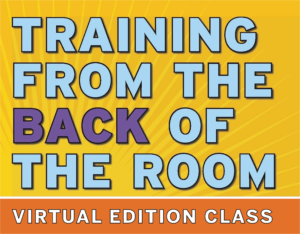Is Live Virtual Learning Really Helping Learners? – Contributed by Jean-Paul Bayley (reposted)

Eight-hour training days may be the norm for in-person training, but it’s a poor format for live virtual training. The overwhelming temptation for trainers is to maintain the status quo when offering classes online. However, this flies in the face of science, academic practices, and decades of professional reports of successful virtual learning experiences.
The Problem:
Back in April 2020, I published a post titled “When Everything is Suddenly Virtual.” In it, I researched what scientists and expert practitioners were saying and concluded that “shorter trumps longer” when training online. In fact, expert advice suggests that the ideal session length is anywhere from 30 minutes to 2 hours. In spite of this, many virtual courses are currently listed as two days of 7-8 hours of live online training each day.
Dr. Annie Peshkam and Dr. Gianpiero Petriglieri of INSEAD (one of the world’s top graduate business schools) say there are two main challenges we face with moving learning online. First, we “become fixated on the mechanics rather than on the purpose of learning.” Second, we “focus on content alone.” We do this at the expense of understanding how to reach learners in a live virtual setting. Peshkam and Petriglieri point out that “learning online is a lot more complicated than setting up a Zoom account and continuing business as usual.”
Zoom Fatigue and Multi-Tasking:
 Many of us spend our days on endless video-conferencing calls. Doing so is a major psychological and physical drain (the term “Zoom Fatigue” became popular early during the COVID-19 pandemic). So, what is it about being online that makes us tired?
Many of us spend our days on endless video-conferencing calls. Doing so is a major psychological and physical drain (the term “Zoom Fatigue” became popular early during the COVID-19 pandemic). So, what is it about being online that makes us tired?
Dr. Jeremy Bailenson is the founding director of Standford University’s Virtual Human Interaction Lab. In a Wall Street Journal editorial, “Why Zoom Meetings Can Exhaust Us,” Bailenson highlights how video-conferencing makes us behave in a way we would not normally behave. We spend hours gazing at the disembodied heads of the other participants on the screen – often dozens at a time – as they gaze back at us. It makes us feel uncomfortable, a sensation Bailenson calls “nonverbal overload.” He explains that “…enduring long bouts of such contact during Zoom meetings with colleagues and classmates can be emotionally draining and can even stimulate the brain’s ‘fight or flight response.’ Needless to say, such experiences are stressful.”
When we are in a physical training space with each other, we experience movement, touch, smell, and a sense of personal space. We use all our senses with every interaction we have. However, much of that normal sensory data is lost in a virtual training space. We are multi-sensory creatures and when our senses are limited, even at the subconscious level, we have to expend more effort. In effect, our brain has to work a lot harder, which makes the whole virtual experience exhausting.
Because of technology, there are conversation lags, so we must be acutely aware of not talking over each other. In fact, even slight delays in response-time can make us feel anxious or conclude that people are being unfriendly or unfocused. We must employ additional brain mechanisms to try to avoid talking over each other when there is even a tiny delay, and this is exhausting, as well.
In addition to all that, the multi-tasking aspect of being online exhausts us, too. We must focus not only on multiple faces on the screen, but also chat messages and non-verbal signals such as people muting, turning their cameras off, video background environments and noise, etc. Online apps like a whiteboard, while increasing learner engagement, can also increase cognitive overload. Managing multiple online tasks can lead to Directed Attention Fatigue.
 What Does This Mean for Learning?
What Does This Mean for Learning?
According to all of the research done during 2020 (see bibliography link below), instruction and learning that is done online is stressful and exhausting, both physically and mentally. You, as the trainer, may not be totally conscious of this. However, your training participants experience this, regardless.
Dr. John Medina is a neurobiologist and author of the best-selling book Brain Rules. According to Medina, prolonged stress harms learning, negatively affects short- and long-term memory, impedes our ability to process language effectively, and reduces our problem-solving capabilities. In summation, the negative implications of stress and exhaustion on our ability to learn successfully are massive.
Quick, We Need to Pivot!
Author Cindy Huggett reports in her 2020 State of Virtual Training that there has been a considerable increase in the number of training sessions of over two hours since Covid hit. Huggett concludes that trainers have hurriedly moved courses designed for 1-2 days of in-person delivery to an online mode of delivery without considering the implications. She elaborates: “For long-term success, in-person classes should be translated and transformed when moved online. Organizations should seize the opportunity to redesign the learning experience to maximize all the benefits that virtual training has to offer.”
Some Suggestions for Virtual Learning Success:
As a virtual class trainer, it is within your power to maximize the online learning experience and reduce the stress and exhaustion for your learners. Here are some practical steps you can take to make your training more learner-centric:
 1. Be like NASA. The US National Aviation and Space Administration breaks up long days of live virtual training into shorter sessions spaced out over a longer time period. Using this longer time period between sessions, NASA provides learners with opportunities to do workplace practice and to revisit the content in multiple ways (spacing and retrieval practice). You can do the same: space your content over multiple shorter class sessions, with a day or two in between each session. Let your learners “sleep on it,” reflect, do some offline reading/writing, and come back refreshed and ready to learn more.
1. Be like NASA. The US National Aviation and Space Administration breaks up long days of live virtual training into shorter sessions spaced out over a longer time period. Using this longer time period between sessions, NASA provides learners with opportunities to do workplace practice and to revisit the content in multiple ways (spacing and retrieval practice). You can do the same: space your content over multiple shorter class sessions, with a day or two in between each session. Let your learners “sleep on it,” reflect, do some offline reading/writing, and come back refreshed and ready to learn more.
2. Redesign your class for Live Virtual Training. Do NOT move your in-person class online! Take into account the environment and create a version of your class which makes best use of virtual learning experiences.
3. Stop lecturing and flip your classroom! Move lecture content offline and let learners pick it up at their own pace. Bring everyone together online to discuss, reinforce, practice, and elaborate on what they are learning. Remember the acronym “WAIT” – “Why Am I Talking?” Make that time together count!
4. Remember why you are in the class. Focus on the “need-to-knows” of the learning outcome(s) you are trying to achieve and, fascinating though it might be, let the rest go by.
5. Limit the size of your virtual class groups. Back in April 2020, in my post Small Trumps Large When Training Online, I found that 12-15 class members seems to be the sweet spot here. Small groups of around a dozen give learners more opportunities to actively learn. Small groups also reduce the amount of non-verbal overload and multi-tasking that learners (and trainers/producers!) have to do.
 6. Integrate movement into your training. “Movement trumps sitting” is even more important online and yet harder to do. Think about all the ways you can suggest that learners move while video-conferencing: analog signals like hands in the air or thumbs up, wiggling parts of their bodies, bending forward/backward and side-to-side. You can also ask for volunteers to lead quick 15-second sitting and standing stretches every 5-10 minutes.
6. Integrate movement into your training. “Movement trumps sitting” is even more important online and yet harder to do. Think about all the ways you can suggest that learners move while video-conferencing: analog signals like hands in the air or thumbs up, wiggling parts of their bodies, bending forward/backward and side-to-side. You can also ask for volunteers to lead quick 15-second sitting and standing stretches every 5-10 minutes.
7. Include stretch and tech breaks every 45-60 minutes. Put 5-10 minute stretch and tech breaks in your training plans and ask learners to step away from all tech during the breaks. Explain that they need to stand up, stretch, and move around, get some fresh air, and take a drink of something (non-alcoholic!) to refresh their eyes, body, and brain.
8. Pair up with another trainer or a producer. Do not forget to look after yourself. If you, as a trainer, are tired and stressed, how can you help your learners learn? Having extra help reduces your cognitive load and makes for a smoother, more pleasant online training experience.
A Call to Action:
Let us imagine learner-centric online training which embraces opportunities for Spaced Practice, Retrieval Practice, Interleaving, Feedback-Driven Metacognition. Think about virtual training that calls learners together to elaborate and enhance their shared understanding, rather than subjecting them to a lecture-broadcast or death-by-slides. Imagine virtual training that takes place as short sessions over several days and therefore puts the physical and psychological needs of the learners first. Imagine successful virtual learning that sticks – imagine that!
*****************************
For the complete article (from which this blog post originated), click HERE.
For the bibliography and research on which this blog post was based, click HERE.
For more information about Jean-Paul’s TBR-VE™ Class, click on the link below:
TBR-VE™ Class (TBR – Virtual Edition)
Further Reading:
4 Differences Between the Virtual and the In-Person TBR Classes
When Everything Is Suddenly Virtual
Small Trumps Large When Training Online
*******************************
About the Author:
 Jean-Paul Bayley, England
Jean-Paul Bayley, England
TBR Certified Trainer Jean-Paul Bayley is a partner of Actineo Consulting LLP – a Business Agility Consultancy. Jean-Paul’s mission is to share how to create fun, engaging and memorable learning experiences. Using the skills that he has honed during his career as a consultant, coach, and trainer, he now helps individuals, teams, and organizations achieve their professional goals. He has written 3 other blog posts for Sharon Bowman’s website: 3 Anti-Patterns of Training, Anti-Patterns of Training – Part Two and TBR, Psychological Safety, and C1-Connection Activities. You can follow Jean-Paul on Twitter @jpbayley.
*******************************
